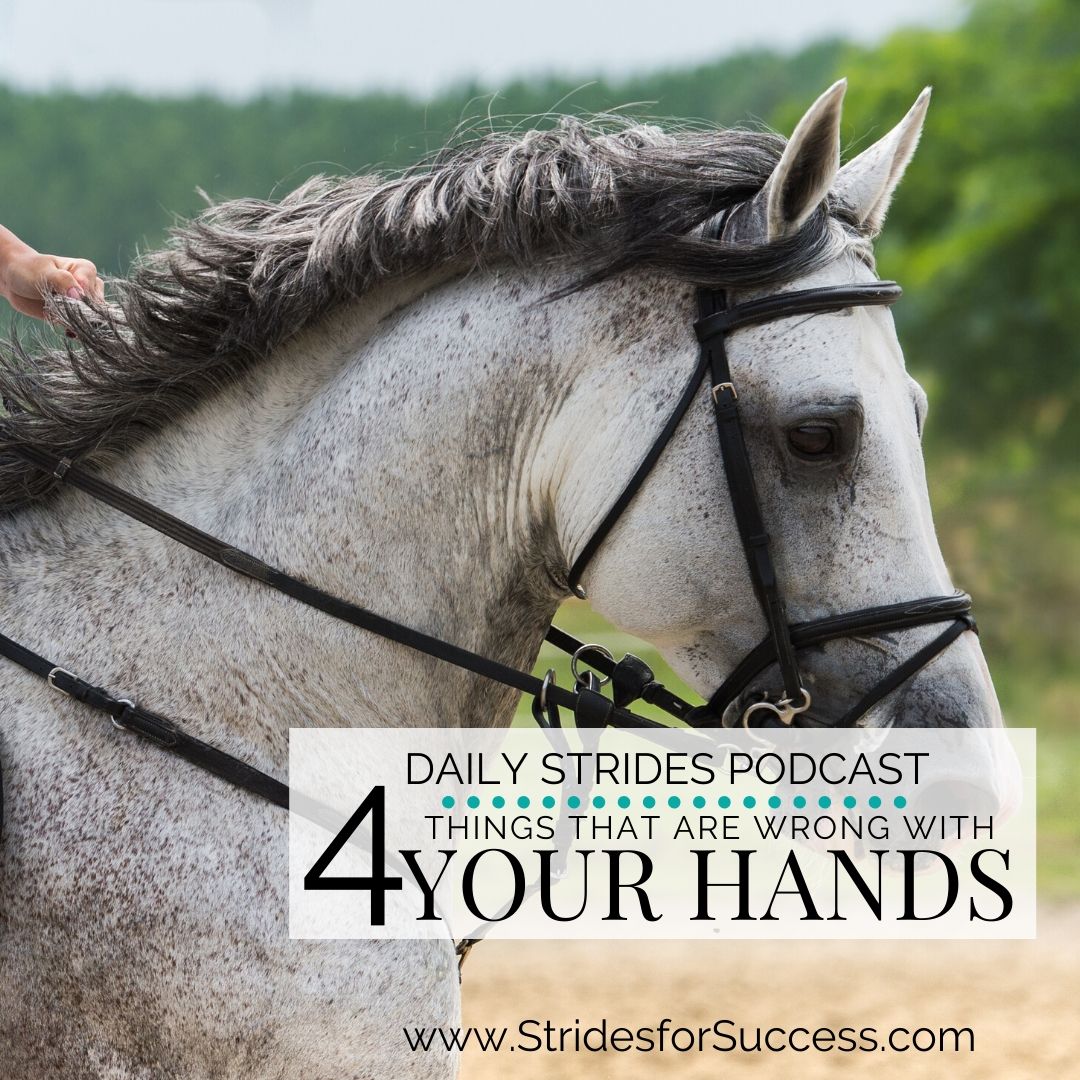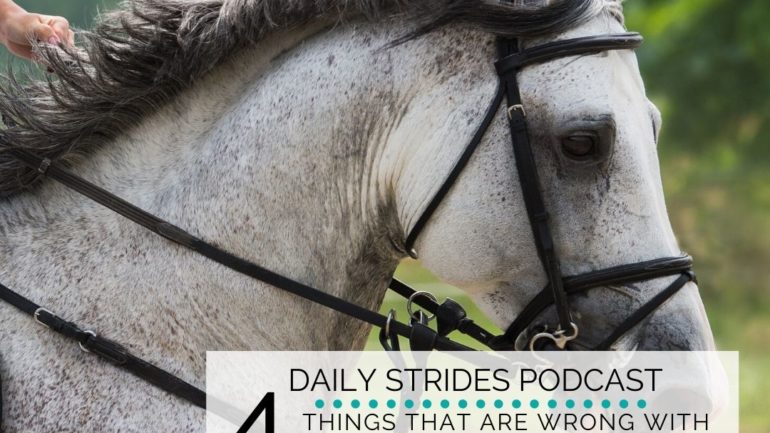
As I was creating my notes for this episode, it struck me that there is a strong probability that this sounds a lot like Goldilocks! Too much, too little and ‘just right’ will come up repeatedly as I begin talking about your hands when you are riding. Obviously, we are aiming to achieve ‘Goldilocks’ hands; just right!
But seriously, the reason I recorded this episode is due to so many riders struggling with their hands. They are trying to improve contact and connection. However, they are actually missing some of the basics of the hand aids. And I think that making sure your hands are being useful, rather than confusing, is a really important basic that many riders are missing.
So, that all being said, let’s dive into the 4 things that you may be doing with your hands while riding that is negatively influencing your conversation with your horse.
1 . Too Much Fidigiting on the Reins
Piano Fingers. In my experience, once a rider has caught on to this habit it can be a really tough one to break. Piano Fingers is my name for hands that are continuously moving up and down the reins during each ride. They move closer to the bit, causing a lot of tension on the rein and contact. And then, without any word of warning, everything changes as they move closer to the buckle of the rein.
Up and down the hands go throughout the ride. This is usually accompanied by statements about ‘lack of contact’ being uttered by the rider from time to time…
Piano fingers make it really difficult for both the horse and the rider to settle into any sort of rhythm regarding the overall communication. There literally cannot be a contact, because the riders only consistency surrounding it is to continue to drop it!
The good news is that, with a little mindfulness and attention, you can remedy this quite easily. The first thing to make sure of is that you are holding the reins correctly. As the rein comes into your hand, it passes between your little finger and ring finger. Then it comes up the inside of your fingers, to pass over the top of your index finger.
Your fingers don’t ‘hold’ the rein. That is a job for your thumb. As the rein passes over your index finger, you thumb presses down there, allowing you to hold and maintain the contact.
Holding the rein with your thumb also frees up your fingers to ask different questions using the reins and contact with your horse.
2 . Carrying Your Hands Too High or Too Low
One of your responsibilities as a rider is to carry your own hands. So many riders fail to do this. They allow their hands to rest on the horse or on the saddle as they ride. Doing this makes the hand aids completely ineffective in the conversation between horse and rider.
Carrying your hands’ too low or too high changes how the bit applies pressure to your horse’s mouth. It also changes how supple your arms are when following the horse and connecting with the contact.
Correcting this simply requires you to pay attention to your lines. From a side view of you and your horse, there should be a straight line from your elbow to your horse’s bit.
If you see a V shape, your hands are probably too low. If you see a ^ shape, your hands are probably too high. Your hand will cause the ‘point’ in the V or the ^ with your arm making one side and the rein creating the other.
Hands being held too high is often due to nerves or anxiety on the part of the rider. Many riders look like they are directing air traffic, rather than simply allowing their hands to be the quiet aid that they should be in their riding.
Hands that are too low can be due to either a failure to carry them, laziness! Or it can be due to some misguided attempt to the horse ‘on the bit’ by holding the hands closer to the knees and sawing the bit in the horse’s mouth. Please DON’T do this! Your horse tucking his head in to get away from your painful sawing is not traveling ‘on the bit’!
3 . Carrying Your Hands Too Close or Too Wide
Are you beginning to see why I mentioned Goldilocks at the beginning?! How close your hands are in relation to each other when you ride will depend on a lot of things. Your skills as a rider play the biggest role in deciding this. However, your horse’s experience and ability to understand aids also plays a part. Finally, the question you are asking at any given time will also dictate where your hands are in relation to each other as you ride.
For most riders, carrying your hands 6 to 8 inches (so 15cm to 18cm) apart is a good rule of thumb. This seems to allow both horse and rider to understand the questions and respond accordingly.
As you and your horse develop the conversation you have together more, you can refine this. Refining simply means that your hand aids become more subtle. So, in this case, moving your hands closer together.
However, if you start off with your hands’ side by side, you will probably end up confusing both yourself and your horse in the long run! Your confusion will come down to correctly using ‘outside and inside’. Your horses will come from the pressure seeming to come from the same place.
Remember, all aids can be refined, and how close together with your hands are is one way you can refine your hand aids.
4 . Too Hard or Too Soft
The final mistake I want to cover today that many riders make in the saddle is, intentionally or not, having hands that are too soft or too hard on their horse’s mouth. Let’s deal with the more obvious one first; too hard. Too hard is when the pressure is too much all the time on the contact between horse and rider. It is the difference between ‘asking’ and ‘forcing’ the horse to do something.
However, too soft is also an issue when it comes to your hands and hand aids while riding. Too soft is often a reflection of your leadership skills, an essential part to becoming a better rider.
Soft hands are usually due to a rider who lacks confidence in their own abilities in the saddle. They worry that they will hurt the horse by becoming unbalanced and leaning on the reins for support. Now, obviously, this is a valid concern at the early stages of your riding.
However, there comes a point when you have to begin working on your core stability and independent balance as a rider. The more confident you are in your own abilities, the more you will reflect this in how you communicate with your horse using your hands.
Finding Your ‘Goldilocks’ Hands
Your aids will always be a work in progress. You will refine them more and more as you develop your conversation with your horse. However, I feel that it is good, to be honest with yourself from the beginning of your riding. Remember, all of your aids work together. There is a ‘Balance of Aids’ in play, always.
You hands must support your other aids while you are in the saddle.
Finding your initial ‘happy place’ or Goldilock’s hands will help you to show up more consistently for your horse every time you mount up.
Happy Riding
Lorna

